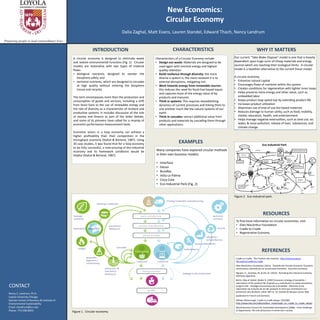Signaler
Partager
Télécharger pour lire hors ligne

Recommandé
Recommandé
Contenu connexe
Tendances
Tendances (20)
Shifting Mainstream Consumption Patterns Towards a Circular Economy Transition 

Shifting Mainstream Consumption Patterns Towards a Circular Economy Transition
The Circular Economy - Prospects and Challenges 2017

The Circular Economy - Prospects and Challenges 2017
Changing mindset in a cirular economy anne raudaskoski_ethica_berlin june 2018

Changing mindset in a cirular economy anne raudaskoski_ethica_berlin june 2018
Innovation, Environmental Policy And Lock In Effects

Innovation, Environmental Policy And Lock In Effects
Circular economy - a new paradigm in manufacutring

Circular economy - a new paradigm in manufacutring
Towards the Circular Economy: Accelerating the scale-up across global supp...

Towards the Circular Economy: Accelerating the scale-up across global supp...
Sustainable engineering - Measures for Sustainability

Sustainable engineering - Measures for Sustainability
Similaire à Circular economy
Similaire à Circular economy (20)
Sustainable Energy Management: Reducing Waste with Lifecycle Thinking

Sustainable Energy Management: Reducing Waste with Lifecycle Thinking
Scoullos_Cours-EVEC-Etudiants-16-mars-2022_Circular-Economy.pdf

Scoullos_Cours-EVEC-Etudiants-16-mars-2022_Circular-Economy.pdf
Understanding Biosphere Entrepreneurship Through a Framework Approach

Understanding Biosphere Entrepreneurship Through a Framework Approach
How to understand and teach upcycling in the context of the circular economy:...

How to understand and teach upcycling in the context of the circular economy:...
A new consonant_approach_of_circular_economy_based (1)

A new consonant_approach_of_circular_economy_based (1)
4 ME PPT _ MT-I Energy Rate Forming Processes .21.03..2023.pptx

4 ME PPT _ MT-I Energy Rate Forming Processes .21.03..2023.pptx
Circular economy
- 1. To find more information on circular economies, visit: • Ellen MacArthur Foundation • Cradle to Cradle • Regenerative Economy Our current “Take-Make-Dispose” model is one that is heavily dependent upon huge sums of cheap materials and energy sources which are reaching their ecological limits. A circular model is a healthier alternative to the current linear model. A circular economy • Enhances natural capital • Encourages flows of nutrients within the system • Creates conditions for regeneration with tighter inner loops • Helps preserve more energy and other value, such as embedded labor • Keeps product loop speed low by extending product life • Increases product utilization • Maximizes use of end-of-use bio-based materials • Reduces damage to human utility, such as food, mobility, shelter, education, health, and entertainment • Helps manage negative externalities, such as land use; air, water, & noise pollution; release of toxic substances; and climate change New Economics: Circular Economy Dalia Zaghal, Matt Evans, Lauren Standel, Edward Thach, Nancy Landrum INTRODUCTION WHY IT MATTERS EXAMPLES CHARACTERISTICS REFERENCES CONTACT Many companies have explored circular methods in their own business models: • Interface • Desso • Bundles • Veta Le Palma • Coca-Cola • Eco-Industrial Park (Fig. 2) Characteristics of a Circular Economy include: • Design out waste: Materials are designed to be used again with minimal energy and highest quality retention • Build resilience through diversity: the more diverse a system is, the more resistant it is to external disruptions, mitigating risk. • Work towards energy from renewable sources: this reduces the need for fossil-fuel based inputs and captures more of the energy value of by- products and manures. • Think in systems: This requires reestablishing dynamics of current processes and linking them to one another much like the natural systems of our earth. • Think in cascades: extract additional value from products and materials by cascading them through other applications. Cradle to Cradle. The Product-Life Institute. http://www.product- life.org/en/cradle-to-cradle Ellen MacArthur Foundation (2012). Towards the Circular Economy: Economic and business rationale for an accelerated transition. Executive Summary. Nguyen, H., Stuchtey, M.,& Zils, M. (2014). Remaking the industrial economy. McKinsey Quarterly. Börlin, Max et Stahel, Walter R. (1987) Economic strategy of durability – valorisation of the product-life of goods as a contribution to waste prevention. (original title : Stratégie économique de la durabilité - éléments d'une valorisation de la durée de vie des produits en tant que contribution à la prévention des déchets); cahier SBS no. 32, Société de Banque Suisse, Bâle (published in French and German). William McDonough: Cradle to cradle design. TED2005. http://www.ted.com/talks/william_mcdonough_on_cradle_to_cradle_design World Business Council for Sustainable Development (2006). From Challenge to Opportunity: The role of business in tomorrow’s society. Nancy E. Landrum, Ph.D. Loyola University Chicago Quinlan School of Business & Institute of Environmental Sustainability Email: nlandrum@luc.edu Phone: 773-508-8953 A circular economy is designed to eliminate waste and restore environmental functions (Fig. 1). Circular models are restorative with two types of material flows: • biological nutrients, designed to reenter the biosphere safely, and • technical nutrients, which are designed to circulate at high quality without entering the biosphere (reuse and recycle). The term encompasses more than the production and consumption of goods and services, including a shift from fossil fuels to the use of renewable energy and the role of diversity as a characteristic of resilient and productive systems. It includes discussion of the role of money and finance as part of the wider debate, and some of its pioneers have called for a revamp of economic performance measurement tools. Economic actors in a loop economy can achieve a higher profitability than their competitors in the throughput economy (Stahal & Borland, 1987). Using 30 case studies, it was found that for a loop economy to be fully successful, a restructuring of the industrial economy and its framework conditions would be helpful (Stahal & Borland, 1987). RESOURCES Figure 1. Circular economy. Figure 2. Eco-industrial park.